How Manstein saved the German army from the Caucasian "cauldron"
Manstein simply did not have the physical ability to simultaneously rescue the Stalingrad Paulus group, “cover his back” to Kleist in the Caucasus and hold all points of the front, much less stop the enemy and regain previously lost positions, as the German Stavka pointed out to him. There were no reserves, all requests from the headquarters of Army Group Don to transfer at least three divisions from the Kleist group to reinforce Goth, the Headquarters categorically rejected. They threw all those who could on the front line - air defense units, battle groups made up of the rear men, vacationers and convalescents.
At the same time, the army of Paulus has already been written off. Manstein hoped that the German "Stalingrad Fortress" would last as long as possible, diverting the forces of the Red Army. On the evacuation of the 1st tank Army from the North Caucasus - the withdrawal of troops, the removal of heavy equipment, hospitals, various military equipment and materials - Army Group “A”, according to Kleist’s report, required 155 train levels and 25 days. Hope remained on the German ability to maneuver and command troops, creating strike groups and delivering counterattacks, if necessary, to retreat, surrendering less important positions. And these are the Germans, we must give them their due, they knew how to the very end of the war. Manstein had to hold Rostov-on-Don to the end, ensuring the withdrawal of the 1st Panzer Army from the North Caucasus, and for this it was necessary to caste forces from its right flank to the left and organize a powerful counterattack to hold on until the spring thaw.
January
5 January 1943, the Germans left Morozovsk. The Hollidt group slowly retreated to the Seversky Donets, having the task of slowing down the enemy’s advance as much as possible, preventing him from breaking through to the crossings at Belaya Kalitva, Kamensk-Shakhtinsky and Voroshilovgrad. Protecting, thus, approaches to Rostov from the north.
A strong 3-I Guards Army of the South-Western Front, commanded by Lieutenant-General D. D. Lelyushenko, which had, in addition to rifle divisions, three separate tank regiments, 1-th Guards Mechanized, 2-th Guards and 25-th tank corps. In addition, the army of Lelushenko was soon further strengthened, and received two fresh tank corps - 2 of Major General A. F. Popov and 23 of Major General E. G. Pushkin. The 5-I tank army of Lieutenant-General M.M. Popova (1 and 22 tank corps, 40 Guards, and two rifle divisions). Lelyushenko's troops attacked Kamensk, and Popov's tank army developed an offensive against Tatsinskaya. Kamensk, who was defended by the Fretter-Pico group, transferred to the group of the Don Army, and a month later remained in the hands of the enemy. German infantry fought bravely and steadfastly. General Hollidt flexibly maneuvered three of his tank divisions, promptly throwing them into crisis points and inflicting short but sensitive counterattacks. As a result, the command of the 3 Guards Army could not use its power advantage and strike power (mobile units).
Along the northern coast of the Don, at the junction of two German army groups, the 5-I attack army of Lieutenant-General V.D. Tsvetaeva.
In the triangle of the Don, Kuberle, Manych rivers, the four divisions were beating the Soviet attacks of the fairly battered and weakened 4 Tank Army of Goth. The 57 tank corps suffered heavy losses, especially the 23 and 17 tank divisions suffered, the 16 motorized division was also dramatically bled. Romanian troops were completely demoralized and fled or surrendered at the first onslaught. Only the SS Viking division, redeployed from the Caucasus, was fully operational. And General Gotu with these forces needed to solve two complex tasks: 1) to prevent the breakthrough of the Soviet troops to Rostov along the lower reaches of the Don on its left flank; 2) on the right - to ensure the withdrawal of the 1-th tank army.
The commander of the Southern Front, Eremenko, planned to surround and destroy Goth's troops as soon as possible. 2-I Guards Army under the command of Lieutenant-General R. Ya. Malinovsky, who developed the offensive from east to west, was aimed at capturing the villages of Tsimlyanskaya and Konstantinovskaya, followed by a turn to the south. The 2 th Guards Mechanized Corps of General KV Sviridov and the 3 Th Guards Tank Corps of General P. A. Rotmistrov were on the edges of the two shock groups of the army. On the left wing of the Southern Front, the troops of the 51 Army, Major General N. I. Trufanov, in cooperation with the 28 Army, Lieutenant General G. F. Gerasimenko, moving along both banks of the Manych, were to close the trap.
On January 3, the 2 Brigade of the Guards Mechanized Corps took possession of Tsimlyansk, threatening the backs of the Hollidt group. Its commander was forced to begin withdrawing his right flank to the Kagalnik River. By 6 in January, the corps of Rotmistrov by the forward detachment broke into the stanitsa of Semikarakorskaya, captured a bridgehead on the north bank of the Don, and with the main forces began the battle for the stanitsa of Konstantinovskaya. A day later, after a five-day heavy battle, the troops of the 51 Army occupied the stronghold and the Zimovniki railway station. The 6 th mechanized corps of Major General S. I. Bogdanov overturning the Viking division became known as the 5 Guards Zimovnikovskim. True, the case itself suffered serious losses. But in the second echelon there were 4-th and 3-th Guards Mechanized Corps, and the 28-I army with mobile units came out to the Steppe. Advanced Soviet troops appeared in 20 kilometers from Novocherkassk, which housed the headquarters of Army Group Don. Manstein had to relocate to Taganrog.
January 5 LF tasks clarified. The 5 Shock Army and the General Kreiser group from the 2 Guards Army by the end of January 7 had to go to Seversky Donets and proceed to force it. The 3 Guards Tank Corps with two infantry divisions had to seize the crossings at Bagaevskaya on the Don and at the village of Vesely on the Manych. By the same time, the 51-I Army and the 3-th Guards Mechanized Corps were to seize Proletarskaya and Budyonnovskaya with a blow from the west.
However, the Germans fought skillfully and bravely, put on strong counterattacks and did not want to be surrounded. On January 9, General Hollidt, having transferred the 11 Tank Division to her right flank (she had become a fire brigade), launched a counterattack against General Tsvetaev’s army and the Kraiser group, squeezing it out and forcing it to go on the defensive. To repel this attack, General Eremenko even had to ask for help from his neighbors - the 5 tank army. For several days the right wing of the law firm could not advance further. The center and the left wing moved extremely slowly - on 2 - 3 km per day. By 14 - 15 January, our troops liberated the villages of Batlaevskaya, Atamanovskaya and Orlovskaya. Only on January 17, front-line troops reached the eastern bank of the Seversky Donets River and the northern bank of the river and the Manych channel, where they again met strong enemy resistance. The German 57 Tank Corps of Kirchner continued to hold the bridgehead east of Proletarian. Here the Germans first threw into battle the 503 heavy tank battalion, which had in its composition tanks "Tiger".
Thus, the Soviet offensive stopped. Skillful actions of the German command played their role, with the help of a maneuver, violent resistance and counterstrikes restraining the advance of the superior forces of the Red Army, as well as the mistakes of the Soviet command. In addition, in the Soviet troops, far removed from their supply bases, there was an acute crisis in the supply of ammunition and fuel.
Trying to break through to Rostov, the command of the Southern Front decided to form two mechanized groups: 1) in the 2 Guards Army Band - consisted of General Rotmistrov's 3 Guards Tank Corps, 2 and 5 of the Guards Mechanized Corps and X-NXX-th Gunty Infantry Corps, and XNUM-88 and 2. ; 51) Trufanov's 3 Army was attached to the 4 and XNUMX Guards of the Mechanized Corps aimed at Azov.
On January 19, the Rotmistrov mechanized group launched an offensive that developed successfully at first. Guardsmen crossed the Manych River in the area of its confluence with the Don, liberated the stanitsa Manychskaya, and captured an important bridgehead. The forward detachment under the command of Colonel A. V. Egorov (eight T-34 tanks, three T-70 tanks, five armored vehicles, nine armored personnel carriers and 200 fighters) by dawn 20 broke through to Bataysk, breaking the railway south of the city. The main forces of the mechanized group were to follow Yegorov. However, to consolidate the success of the vanguard failed. The Germans immediately counterattacked, forced the detachment of Yegorov to retreat. At the same time, the Germans tied up the main forces of Rotmistrov in the area of the stanitsa Manychskaya. This allowed Manstein to gain time for the transfer of additional forces to the crisis area.
On the left flank, the troops of the 51 Army stormed Proletarskaya and forced the Manych. The advanced units of the 28 Army combined with the 30 Division of the 5 Cavalry Corps of the Transcaucasian Front. By January 22 troops of the Southern Front was released Salsk. Thus, the Soviet troops came to Rostov and there was a danger of blocking the German units under the command of Field Marshal Kleist from blocking the withdrawal of troops from the Caucasus.
However, at the same time, the German 11-I tank division Balka crossed the Don at Rostov. Along the southern coast Manych climbed to the mouth of the 16-th part of the motorized Schwerin division. 23 January The 11-I tank division, in conjunction with the 16 Moto Division, launched a counterattack against the advancing Soviet troops and drove them to the village of Manychskaya. January 24 German troops attacked the village, but were repulsed. As F. Mellenthin notes in his memoirs, "Wehrmacht Armored Fist": "January 25 The 11-I tank division was ordered to eliminate the bridgehead of the Russians at any cost." After a stubborn battle, during which General Balk misled the Soviet command by imitating a false attack, the Germans managed to push the Soviet troops across the Manych River.
Soviet troops suffered heavy losses. 26 on January 2013. In a military report on the name of the commander of the 2 th Guards Army, 5 reported that 7 tanks and 7 anti-tank guns were left in the 2200 Guards Mechanized Corps, the number of "active bayonets" was reduced to X-UMTHMX The rest of the mobile units also lost their strike power: the 2 Guards Mechanized Corps had 8 tanks on the move, 3 Tank Tanks - 14 tanks. As a result, the mobile units of the mechanized groups temporarily lost the ability for active hostilities.
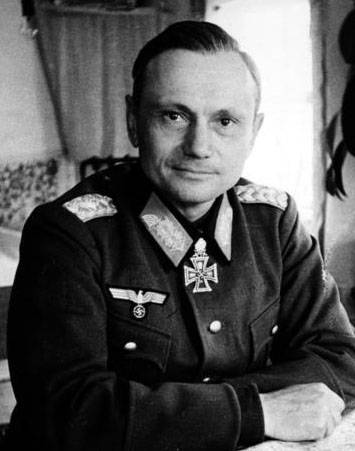
Commander of the 11 Panzer Division Herman Balk (Balck)
Thus, the counterstrike of the 11 Tank Division allowed temporarily stopping the advance of the Soviet troops on Rostov from the south. “For several weeks, the division made marches every night,” General G. Balk noted, “before dawn, always finding themselves in the most vulnerable place for the enemy and striking an hour before the Russians came. This tactic required incredible pressure from the troops, but then we had few casualties, because we always achieved complete surprise. In the division, it was considered an axiom that “night marches save life”, but justice demands that no one at that time could tell you plainly when our soldiers slept ... ”.
All further attempts of the Southern Front to take Rostov and Bataysk and to intercept the withdrawal of the enemy's Caucasian grouping east did not lead to success. Manstein, maneuvering and striking in retaliation, still held out. In January, the troops of Eremenko advanced by 150 – 200 kilometers, but they could not take Rostov and block the 1 Tank Army in the Caucasus.
February
Only in the beginning of February 1943, after a general change in the situation on the southern wing of the Soviet-German front, when the Red Army launched an offensive on the Seversky Donets, Rostov was liberated. Manstein made the decision to withdraw the 4 tank army from the lower reaches of the Don and Donets, redeploying its left flank to the Don group and the Hollidt group to take the old positions on the Mius River, and leave Rostov-on-Don. Due to a significant reduction in the front line, the battle formations were consolidated and mobile units were released, which made it possible to create reserves and in the future to launch a counterattack.
The troops of the Southern Front 7 February occupied Bataysk and Azov. On the night from 7 to 8 in February, the Goth connections began to depart from the Batai bridgehead for the Don, and the Hollidt group went to the Kamensk-Novocherkassk intermediate line. The enemy front troops didn’t notice the maneuver of the enemy immediately, but when they did, they began to pursue. Units of the 28 Army forced the Don across the ice and began an assault on Rostov. The city was defended by the 126 Infantry Regiment, the battle group of the 23 Armored Division and the 503 Heavy Tank Battalion attached to it. “Tigers” in combat conditions confirmed their inability to street battles, showed good weaponry, powerful armor and susceptibility to “childhood diseases”.
12 February 5-I tank army liberated Kamensk-Shakhtinsky, 5-I attack army - Mines, 13 in February 2-I Guards Army - Novocherkassk, 14 in February 28-I army - Rostov. The German command redeployed its troops to the advance defense line along the r. Mius. An attempt by the LF troops to break through this milestone was not a success, and on February 18 they went over to the defensive.
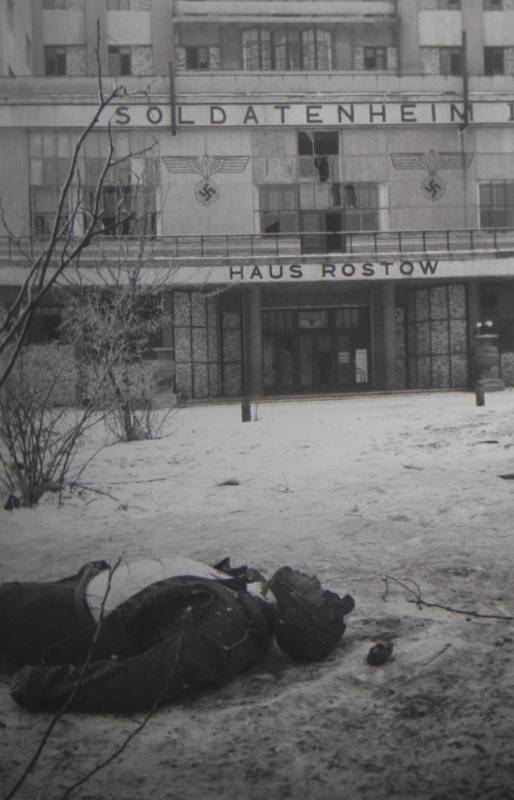
The corpse of a German soldier on the streets of the liberated city of Rostov-on-Don
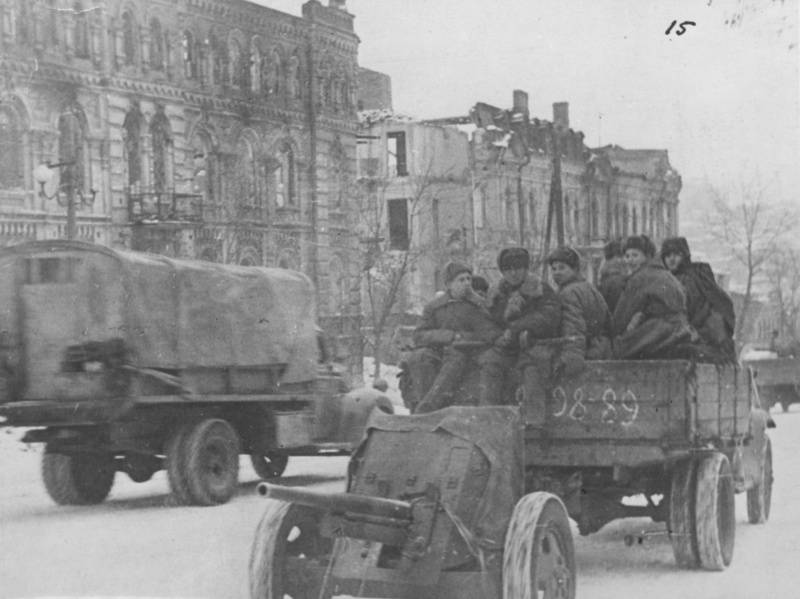
The soldiers in the back of a truck traveling down the street Engels in the liberated Rostov-on-Don. 45-mm anti-tank gun model 1937 of the year is attached to the truck
Results
As a result of the Rostov operation, Soviet troops advanced to a depth of 300 — 450 km, and liberated most of the Rostov region. Enemy Army Group "Don" suffered a defeat, but retained combat capability. Because of the skillful actions of the enemy, the mistakes of the Soviet command of the LF, it was not possible to cut off the enemy’s withdrawal routes from the North Caucasus through Rostov and to create a huge “cauldron”.
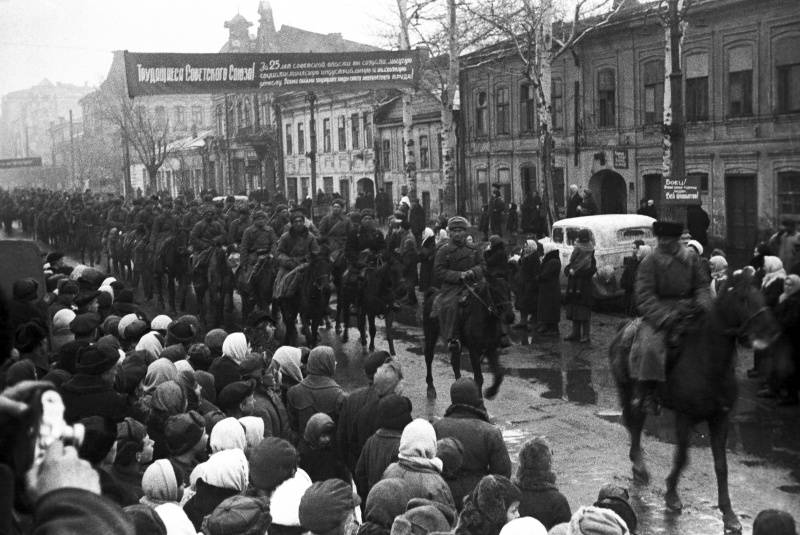
Residents of the liberated Rostov-on-Don meet Soviet horsemen on Engels Street at the monument to S. M. Kirov
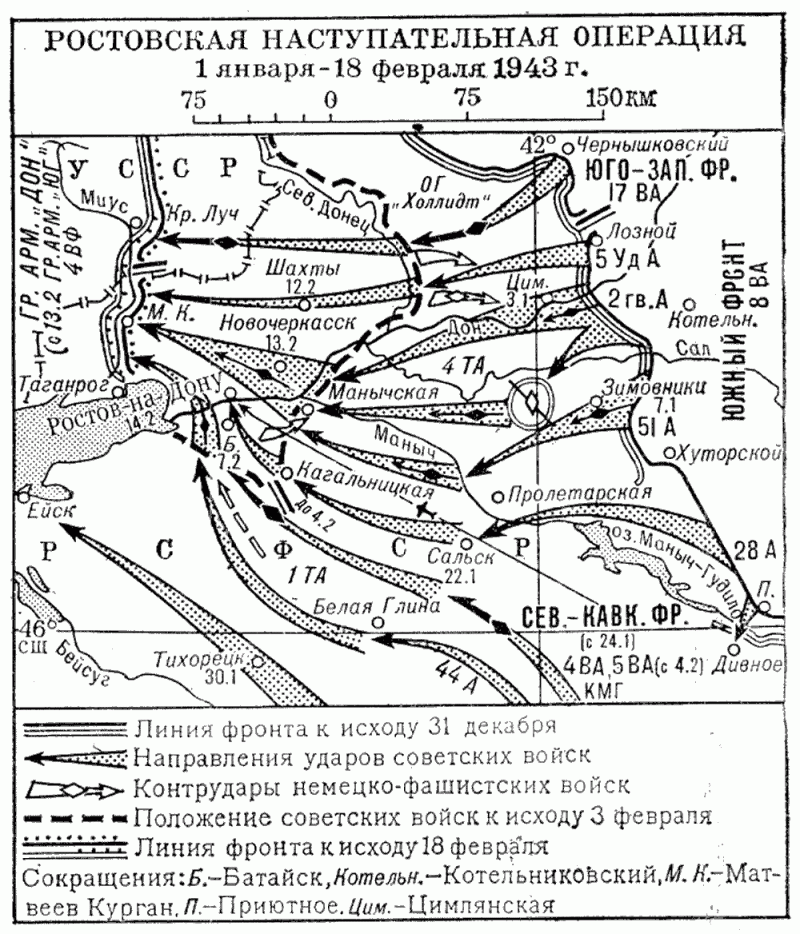
Information